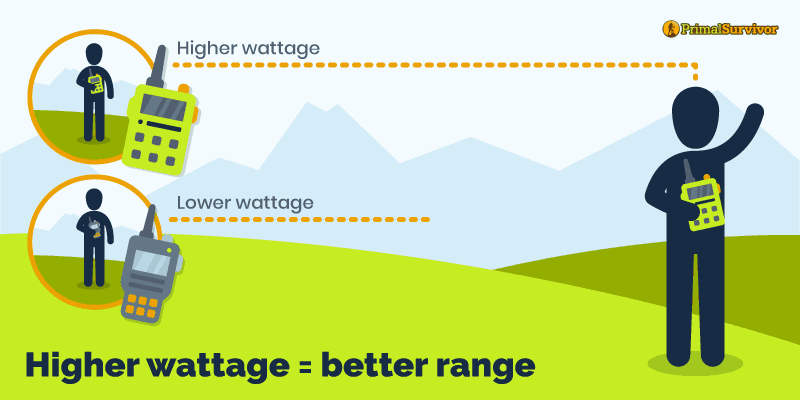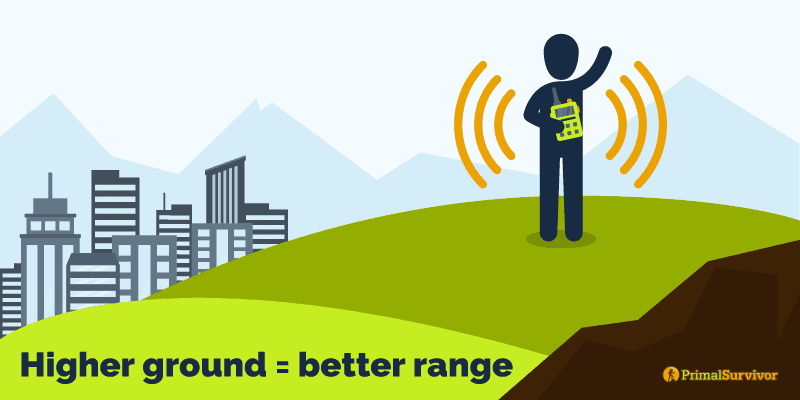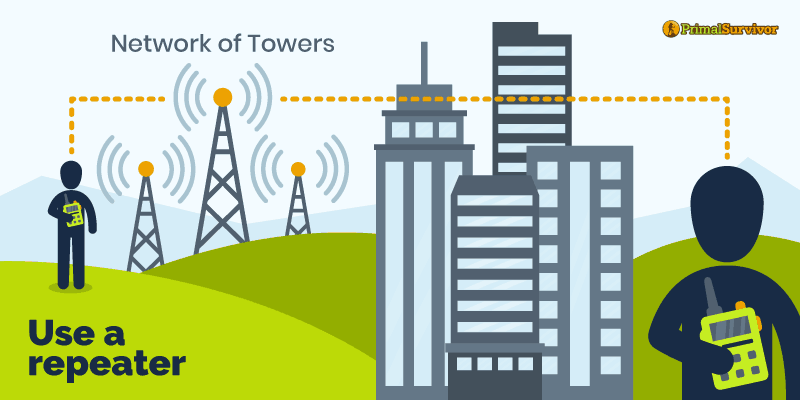When disaster strikes, there’s nothing more stressful than being unable to communicate with family and friends. Walkie-talkies may feel old-fashioned in these days of smartphones, but they may be your best bet in an emergency.
Cell phones are great for day-to-day communications, but network gridlock, damage to infrastructure, or the need to escape to a remote location are all reasons not to trust your cell when SHTF.
A portable two-way radio (otherwise known as a walkie-talkie) is your best option for emergency communications.
 BTECH GMRS-V2 (2nd Generation)
BTECH GMRS-V2 (2nd Generation)
Offers the best combination of price, range, and functionality for most preppers.
Best Long Range Walkie Talkies
Best All Rounder – BTEC GMRS-V2
Output: 5 watts | Weight: 8 oz | Privacy codes? Yes | License required? Yes
This is the second generation of BTEC’s well-regarded radio. The build quality and performance make this one of the best walkie-talkies if you don’t want to get a Ham license.
The range is variable, but users have reported getting up to four miles range in urban/forested areas and 36+ miles in clear terrain.
It has 200 programmable channels and unlimited repeater support.
The antenna is also removable, so you can switch it out for a more effective whip antenna to boost range.
The GMRS-V2 has a built-in FM radio and plenty of programmable scanner channels, which you can set up to receive NOAA weather warnings and other local channels.
Best Ham Option – BaoFeng BF-F8HP
Output: 1, 5 or 8 watts | Weight: 7.8 oz | Privacy codes? Yes | License required? Yes
This is one of the most powerful and best-value handheld walkie-talkies on the market.
BaoFeng doesn’t give an official range, but users have reported being able to hit repeaters at distances of 15-20+ miles in flat or rolling terrain.
In addition to the 8-watt power setting, there are also options to run it at 1 or 5 watts to help conserve battery life.
If the range is the best thing about this walkie-talkie, the second best thing is the battery life. The rechargeable battery will last up to 24 hours, making it a good option if you have to travel to a Bug Out location.
You’ll need a Ham license to use the BaoFeng BF-F8HP and a bit of technical know-how to get it set up, but as Ham radios go, it’s fairly basic. A great option if you want to be able to tap into the Ham radio network away from your home or Bug Out base.
Waterproof Option – Cobra MR HH350
Output: 1, 3 or 6 watts | Weight: 9.59 oz | Privacy codes? No | License required? *Maybe
The MR HH450 is designed as a VHF radio for use in marine or other environments where there’s a high probability of it getting wet.
It’s got a rugged casing, floats in water, and has a bright orange core to help you fish it out of the water if it decides to take a swim.
There are three power settings for short- and long-range communication and a useful ability to replay missed VHF calls.
The Cobra radio is a good option if you need a waterproof walkie-talkie for use on and off the water.
If waterproofness is a ‘nice to have,’ you’d be better off going for the BTEC GMRS-V1 and packing a plastic bag.
Best For Kids – Retevis Walkie Talkies
Output: 0.5 or 1 watt | Weight: 8 oz | Privacy codes? Yes | License required? No
While older teens may have enough interest in radios to train them on a more complex system, for younger kids, you want something simple to use, easy for small hands to manage, and relatively robust.
There are lots of kids’ walkie-talkies on the market, but most are designed primarily as toys rather than functional pieces of emergency kit.
The set of walkie-talkies is a bit of a halfway house.
They’re small and simple enough for all the family to use, but they have a reasonable range, privacy codes, and a keypad lock, so you don’t have to worry about your kids accidentally changing the settings and being unable to communicate with you.
These radios should be suitable for communicating up to about one mile in open or suburban areas.
While this is not “long-range,” it should be sufficient for most occasions when your family could be separated in an emergency.
They’re also great for camping and backcountry trips, allowing kids to explore while still being contactable.
They’re a great budget buy, as you get two in a pack. They use AA batteries and hold the charge well, but you’ll want to take the batteries out if storing them for a while.
What Type of Walkie-Talkie Should You Buy?
Buying a long-range walkie-talkie can be a complicated business. It’s worth reading our Complete Guide to the Best Two Way Radios for a detailed guide to the pros and cons of the different options.
But essentially, it boils down to these three most likely options:
Ham radio – useful if you want to communicate with the emergency services or other amateur radio users across the country to share information on what’s happening in different areas. Handheld devices typically give a range of up to 20 miles. Ham radio is very much at the ‘techie’ end of the spectrum – you’ll need to pass a test to get an amateur radio license.
GMRS radio – this is likely to be the best option for communicating with your family across a range of distances. You still need to buy a license, but one will cover your entire family.
FRS radio – you don’t need a license to use FRS radio, and it’s easy to operate. The downside is that range is limited to a mile or two. You’ll find that many long-range walkie-talkies come with both FRS and GMRS channels.
Selection Criteria
Wattage (Power)

The higher the wattage, the more powerful the radio and the further you can transmit. Walkie-talkies are typically limited to 5 watts of power, so it may be worth investing in a more powerful mobile unit if you have a designated Bug Out location.
Different Power Options
The more power you use, the quicker you drain your battery. Walkie-talkies with different wattage options allow you to optimize use for transmission and battery life.
Privacy codes
Privacy codes help filter out communications on a channel that aren’t set to the same privacy code. If there’s a lot of radio traffic around you, this can help you communicate without interference.
NOAA channels
You may have a separate emergency radio for listening to local broadcasts, but having NOAA channels on your walkie-talkies gives you another option for picking up weather and emergency bulletins. This can also be handy if your party is separated, as everyone can pick up alerts directly.
Weight and Battery Life
Cheap walkie-talkies may use AA batteries, but more expensive models will have a single rechargeable lithium-ion battery. Weight and size will be a consideration if you’re tight on space in your Bug Out Bag or if you want a walkie-talkie that’s easy for kids to use.
3 Ways to Boost the Range of Your Walkie Talkie
Let’s talk about the elephant in the room – walkie-talkie range, or how far you can go before your conversation turns to static or cuts out altogether.
Some manufacturers give an estimated range for their radios; others don’t. If they provide a range, it’s usually a maximum value based on “ideal circumstances.”
This means you may get close to the stated range if you were out in the desert with a clear line of sight and a fully charged battery.
In reality, the range is likely to be much more limited, and if you’re in a hilly or urban area, you may only be able to communicate across a few miles, even with a long-range walkie-talkie.
But there are a few things you can do to boost the range of your radio.
1. Know Your Local Geography

Spending time using your walkie-talkies around your local area will help you figure out what obstructions there are to your radio signal. Generally, the higher you get, the better your range. Time to climb that hill…
2. Use a Better Antenna
Replacing the stubby antenna on your walkie-talkie with a whip antenna can help boost your range. Note: You cannot legally use a whip antenna on an FRS radio.
3. Use a Repeater

If you’re using Ham or GMRS radios, you may be able to set up or access a repeater. These receive a signal, increase its power and re-transmit it. They’re often used to overcome obstacles such as mountains or tall buildings.
There’s a national network of repeater towers, but these are privately owned and operated, so you’ll need to request permission before using them.
Conclusion
So which walkie-talkie wins? Well, it depends on what you want it for. You may even decide you need more than one set. After all, it’s always useful to have a backup option…
But if we had to pick a winner, we’d suggest the BTEC GMRS-V2 offers the best combination of price, range, and functionality for most preppers.
If you have kids, a set of Aikmi walkie-talkies are a low-cost, lightweight add-on that can be useful for keeping your family in touch over short distances.






It’s worth noting that privacy channels have nothing to do with privacy. Anyone can monitor all radio-type frequencies and listen to conversations no matter your settings or channels. You never want to say over the radio what you’re unwilling to yell at Walmart. Use codes for sensitive information. Like, I’m going to see Tim later today. Tim could be code for your bugout location. Have these identified in your comm plan ahead of time.
I own a set of btech gmrs radios, and there are two power settings. Low 0.5watt, and hi 2 watts. Not 5 watts as you listed.
Great summary 🙂
The BTECH GMRS-V1 has selectable lod-med-high power up to 5 watts, with locked 1/2 watt on the shared, FRS mid channels, no?
Thanks! Has selectable high and low power settings according to the manufacturer specs.